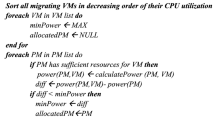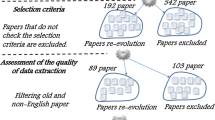Abstract
Popularity of cloud computing is being increased drastically by the use of people all over the world in their comfort zone. For the purpose of withholding the performance of cloud, it is significant to design an efficient scheduling methodology. Researches have designed methods like directed acyclic graph, MinES, MinCS, ant colony optimization, cross-entropy stochastic scheduling, interlacing peak scheduling method, etc for enhancing cloud and user experience. The major problem existed in these methods was higher execution time, overload issues and higher power consumption. To overwhelm the problems, we design a novel framework that is comprised with queue manager (QM), scheduler (SH), virtual machine manager (VMMA), VM allocator (VMA) and VM power manager (VMP). Firstly, in QM the incoming tasks are split into two queues based on task’s deadline, they are represented as urgent queue (UQ) and waiting queue (WQ). Secondly, we perform hybrid scheduling which combines grey system and neural network (GSNN) that considers three significant parameters as task length, CPU intensive and memory intensive. This GSNN scheduling is enabled to withstand effectively even for ‘N’ number of tasks and that leads to minimization of execution time. Then thirdly, each task is allocated to corresponding VM with respect to the capacity and workload of VM. Finally VMP keeps updating the VM information for computing the underutilized hosts then it performs VM migration to put up the idle host to OFF state, for reducing the unwanted power consumption. Simulation results of our entire framework shows improvements when compared with state-of-the-art methods.





Similar content being viewed by others
References
Tsai, C.-W., Rodrigues, J.J.P.C.: Metaheuristic scheduling for cloud: a survey. IEEE Syst. J. 8(1), 1–13 (2013)
Dai, X., Wang, J.M., Bensaou, B.: Energy-efficient virtual machines scheduling in multi-tenant data centers. IEEE Trans. Cloud Comput. 4(2), 1–12 (2015)
Rimal, B.P., Maier, M.: Workflow scheduling in multi-tenant cloud computing environments. IEEE Trans. Parallel Distrib. Syst. 28(1), 1–14 (2015)
Brintha, N.C., Jappes, J.T.W., Benedict, S.: A modified and colony based optimization for managing cloud resources in manufacturing sector. In: 2nd International Conference on Green High Performance Computing (ICGHPC), IEEE, pp. 1–6 (2016)
Atiewi, S., Yussof, S., Ezanee, M., Almiani, M.: A review energy-efficient task scheduling algorithms in cloud computing. In: IEEE Long Island Systems, Applications and Technology Conference (LISAT), pp. 1–6 (2016)
Lakra, A.V., Yadav, D.K.: Multi-objective tasks scheduling algorithm for cloud computing throughput optimization. In: International Conference on Intelligent Computing, Communication & Convergence, pp. 107–113. Elsevier (2015)
Mandal, T., Acharyya, S.: Optimal task scheduling in cloud computing environments: meta heuristic approaches. In: Proceedings of International Conference on Electrical Information and Communication Technology, pp. 24–28 (2015)
Tang, Z., Qi, L., Cheng, Z., Li, K.: An Energy-Efficient Task Scheduling Algorithm in DVFS-enabled Cloud Environment, vol. 14. Springer, New York (2016)
Zhu, X., Chen, H., Wang, J., Yin, S., Liu, X.: Real-time tasks oriented energy-aware scheduling in virtualized clouds. IEEE Trans. Cloud Comput. 2(2), 1–14 (2013)
Zhu, Z., Zhang, G., Li, M., Liu, X.: Evolutionary multi-objective workflow scheduling in cloud. IEEE Trans. Parallel Distrib. Syst. 27(5), 1–14 (2015)
Lu, H., Niu, R., Liu, J., Zhu, Z.: A chaotic non-dominated sorting genetic algorithm for the multi-objective automatic test task scheduling problem, Appl. Soft Comput. 13, 2790–2802 (2013)
Luyta, R., Welchb, C., Lobban, R.: Diversity in gender and visual representation: an introduction. J. Gend. Stud. 24(4), 383–385 (2015)
Pennington, J., Socher, R., Manning, C.D.: GloVe: global vectors forword representation. In: Proceedings of the 2014 Conference on Empirical Methods in Natural Language Processing, pp. 1532–1543 (2014)
Wang, H., Wang, J.: An effective image representation method using kernel classification. In: IEEE 26th International Conference on Tools with Artificial Intelligence, pp. 383–358 (2014)
Chen, Y., Wang, L., Chen, X., Ranjan, R., Zomaya, A.Y., Zhou, Y., Hu, S.: Stochastic workload scheduling for uncoordinated datacenter clouds with multiple QoS constraints. IEEE Trans. Cloud Comput. 1–12 (2016). doi:10.1109/TCC.2016.2586048
He, H., Xu, G., Pang, S., Zhao, Z.: AMTS: adaptive multi- objective task scheduling strategy in cloud computing. China Commun. 13(4), 162–171 (2016)
Zuo, L., Shu, L., Zhu, C., Hara, T.: A multi-objective optimization scheduling method based on the ant colony algorithm in cloud computing. IEEE Access 3, 2687–3699 (2015)
Moganarangan, N., Babukarthik, R.G., Bhuvaneswari, S., Saleem Basha, M.S., Dhavachelvan, P.: A novel algorithm for reducing energy-consumption in cloud computing environment: web service computing approach. J. King Saud Univ. Comput. Inf. Sci. 28(1), 55–67 (2016)
Plank, L., Hellerschmied, A., McCallum, J., Böhm, J., Lovell, J.: VLBI Observations of GNSS-Satellites: From Scheduling to Analysis. Springer, Berlin (2017)
Zhang, Z., Xing, L., Chen, Y., Wang, P.: Evolutionary algorithms for many-objective ground station scheduling problem. In: Bio-Inspired Computing-Theories and Applications, pp. 256–270. Springer (2016)
Meng, X., Xie, Y., Bhatia, P., Sowter, A., Psimoulis, P.: Research and Development of a Pilot Project Using GNSS and Earth Observation (GeoSHM) for Structural Health Monitoring of the Forth Road Bridge in Scotland (2016)
Zuo, L., Dong, S., Shu, L., Zhu, C., Han, G.: A multiqueue interlacing peak scheduling method based on tasks’ classification in cloud computing. IEEE Syst. J. PP(99), 1–13 (2016)
Gu, C., Huang, H., Jia, X.: Power metering for virtual machine in cloud computing-challenges and opportunities. IEEE Access 2, 1106–1116 (2014)
Fan, G., Yu, H., Chen, L.: A formal aspect-oriented method for modeling and analyzing adaptive resource scheduling in cloud computing. IEEE Trans. Netw. Serv. Manag. 11(4), 1–14 (2012)
Yao, X., Geng, P., Du, X.: A task scheduling algorithm for multi-core processors. In: International Conference on Parallel and Distributed Computing, Applications and Technologies, IEEE Computer Society, pp. 259–264 (2013)
Zhu, X., Chen, C., Yang, L.T., Xiang, Y.: ANGEL: agent-based scheduling for real-time tasks in virtualized clouds. IEEE Trans. Comput. 64(12), 1–14 (2015)
Zhu, C., Luan, Q., Hao, Z., Ju, Q.: Integration of grey with neural network model and its application in data mining. J. Softw. 6(4), 716–723 (2011)
Author information
Authors and Affiliations
Corresponding author
Rights and permissions
About this article
Cite this article
Karthikeyan, R., Chitra, P. Novel power reduction framework for enhancing cloud computing by integrated GSNN scheduling method. Cluster Comput 21, 755–766 (2018). https://doi.org/10.1007/s10586-017-0889-1
Received:
Revised:
Accepted:
Published:
Issue Date:
DOI: https://doi.org/10.1007/s10586-017-0889-1




